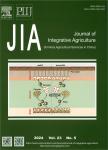Pathotypes and Genetic Diversity of Blumeria graminis *** in the Winter Barley Regions in China
Pathotypes and Genetic Diversity of Blumeria graminis *** in the Winter Barley Regions in China作者机构:College of Plant Protection Nanjing Agricultural University Nanjing 210095 P.R.China National Barley Improvement Center Zhejiang Academy of Agricultural Sciences Hangzhou 310021 P.R. China Institute of Plant Protection Jiangsu Academy of Agricultural Sciences Nanjing 210014 P.R. China
出 版 物:《Agricultural Sciences in China》 (中国农业科学(英文版))
年 卷 期:2010年第9卷第12期
页 面:1787-1798页
核心收录:
学科分类:0710[理学-生物学] 07[理学] 09[农学] 071007[理学-遗传学] 0904[农学-植物保护] 090401[农学-植物病理学] 0901[农学-作物学] 090402[农学-农业昆虫与害虫防治] 090102[农学-作物遗传育种]
基 金:support from the National Natural Science Foundation of China (30671289) the National Key Tech-nologies R&D Program (2006B BAD0 2B 04) the Nationnal Special Fund for Agro-Scientific Research inthe Public Interest (nyhyzx017-001-barley) the Ear-marked Fund for Modern Agro-Industry Technology Research System,China
主 题:Blumeria graminis f. sp. hordei powdery mildew pathotype virulence frequency diversity barley China
摘 要:Barley powdery mildew caused by Blumeria graminis f. sp. hordei (Bgh) is one of the most destructive foliar diseases of barley in the winter barley region of China. The evaluation and assessment of the virulence and diversity of Bgh populations help to determine effective sources of resistance to the pathogen. 515 isolates were collected from seven populations of Bgh on cultivated barley in seven geographically distant locations in 2006. Their virulence was determined by inoculation onto 26 differential host lines. All of the isolates belonged to 58 pathotypes and 13 of which included 81% of these isolates. The most abundant pathotype was pathotype 0047 (18.3%), the second most abundant was pathotype 0045 (11.8%) and the third most abundant was pathotype 0057 (7.8%). Most of virulent genes investigated in this study showed similar frequencies in the seven different areas. These indicate that the seven locations may be in a uniform epidemiological region and barley cultivars in these areas may have similar genetic background. Diversities within these populations and distances between these populations measured by KOIND package were different. Correlations were not found between the genetic distance and the geographical distances between different locations. This suggested that long distance spread and local epidemics existed in the major winter barley growing regions in China.



